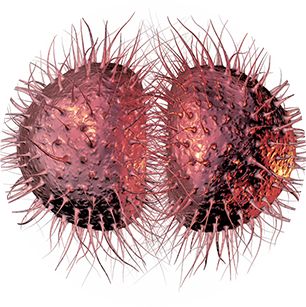The True Colors of Meningococci



Meningococcus is never alone, it is always in pairs and therefore it is called diplococcus.

I'm not as nice as you may think - I have a capsule that is a weapon against your immune system. Thanks to the composition of my capsule, I fight against the good cells of your defense system.
Meningococcus protects against our immune system with the capsule. The capsule is a very important weapon of maningococcus because it protects and repels attacks by our cells, which are the "cleaners" of bad substances and even meningococci.
A meningococcal capsule can usually have 5 different weapons that we call groups - A, B, C, W, and Y.

Where does meningococcus live?

I live in the upper back part of the pharynx (throat), namely the nasopharynx.
Do any of us always have meningococci on our pharyngeal mucosa?
No. People actually rarely have menongococci on their mucous membranes. More commonly meningococci have children up to the age of 2 or sometimes up to 5. Also, young people between the ages of 15 and 20 have significantly more menogococci on their mucosa than other people.
Why is that so?
Both, children and young people often reside indoors, in smaller spaces. Young children in nurseries, kindergartens, and young people in dormitories, but also in cafes and similar collectives where there are many people in a small room.

Meningococcus lives in even 10% of the population without causing troubles. Such people are called healthy carriers.

But when I get into your bloodstream, I start to cause you problems.
An infection occurs, called sepsis meningococci or meningococcemia, it develops very quickly, so it is important to respond in time. Although anyone can be a carrier, the most common carriers are young people and smokers.



How is meningococcus transmitted?
Meningococcus is spread by droplets.
The most common route of transmission is:
Will we get ill if someone passes us meningococcus?
Not always, not all and not often. Our body is a wonderful factory that produces a lot of defense secrets that protect us against microorganisms, including bacteria and meningococci that enter our body in any way. That is why you need to protect and nurture your health and healthy lifestyle.
What is meningococcemia?
When meningococcus crosses into the bloodstream, and our body does not stop it with its defensive weapon, it rapidly multiplies and we call it meningococcemia. While doing so, it attacks all organs of the body. Sometimes it can be very fast so the disease is not even recognized. If the patient does not immediately receive an antibiotic as a drug that will kill meningococci, he may unfortunately die.


What is meningitis?
As the number of meningococci in the blood increases, such blood reaches all human organs, including the brain. The blood crosses the dam we have between the brain and meninx and produces meningitis.
The most common symptoms are:

Fever, diarrhea, nausea, vomiting

Photophobia

Rash with characteristic red spots on the arms, legs or torso


What is photophobia?
An intolerance of artificial and/or natural light; a painful sensation caused by light.
Children simptoms:

Irritability, sobbing, sluggishness.
Adults:

Headache
Loss of appetite
Neck stiffness
Muscle pain
Swollen joints
Confusion
Weakness
How to protect yourself?
The only way to avoid me is to get vaccinated!
There is vaccine for 5 most common meningococcal groups:
the ACWY, AC, C, and B.
Doctors must choose the vaccine that best protects the people in their country. As many people travel the world these days, doctors need to know the destination of their journey before deciding which vaccine to use.

It is important to know all types of vaccines because different groups of meningococci are prevalent in different parts of the world.
America
B and Y
Croatia
B
Europa
B and C
Asia
A and Y
Africa
A and W















